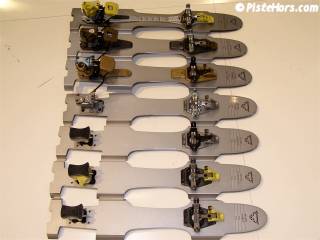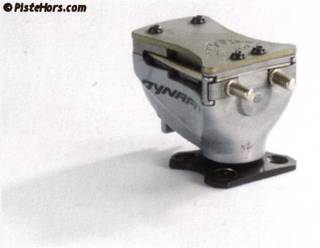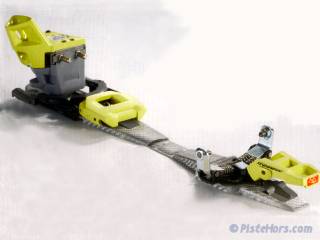
 Dynafit were once the Model-T Ford of bindings, any colour so long as it was orange. The Dynafit TLT binding was super lightweight but its skeletal looks did not inspire confidence amongst some skiers, particularly those looking for a single quiver setup for both piste and randonnée use.
Dynafit were once the Model-T Ford of bindings, any colour so long as it was orange. The Dynafit TLT binding was super lightweight but its skeletal looks did not inspire confidence amongst some skiers, particularly those looking for a single quiver setup for both piste and randonnée use.

After 15 years of solid service on all seven continents the TLT has proved itself to be superbly reliable. So why would Dynafit want to change a winning formula? Well the TLT has some drawbacks. There is little adjustment for different boot sizes, change by a Mondo point and you need to re-drill your skis.
So in 2001 the Tri-Step binding was launched. The minimalist toe piece was partly disguised by a plastic moulding in order to make the binding more acceptable to a wider audience and the heel unit was redesigned to give a whopping 3 Mondo points of adjustment. Unfortunately the plastic cover made it next to impossible to clear the ice which builds up under the tensioning springs stopping the boot from engaging. Not ideal for a ski touring binding. So along came the Dynafit Comfort; mating the TLT’s reliable toe-piece with the easy to use Tristep heel.
Despite the seemingly unbeatable combo of lightweight and reliability Dynafit has obviously started to feel the heat of competition in the form of Fritschi and Naxo at the freeride end of the market and Silvretta (a sister company) for lightweight with conservative good looks.
The first major edition to the range came last year with the introduction of the TLT Race Ti. Now serious competition users have always opted for Dynafit bindings but would replace parts with custom made components in aluminium or titanium to save further grams. Now a lot of us may scoff at the point of shaving 100 grams from an already light binding but over an average ski tour that is the equivalent of lifting 1 tonne of weight over a meter. The Race Ti is strictly a competition binding and Dynafit easily sold the production run.

Complete binding range for the 2007 season
Encouraged by this Dynafit is launching no fewer than 4 new binding models for next season, doubling the size of the current range. The new designs are essentially variants of either the Comfort or TLT.
We think the most interesting is the TLT Speed Lite which logically removes the heel riser. This part is useful for more senior citizens (like me) who lack the skill or flexibility to manipulate the heel without using their pole tip. However as a heel riser we have rarely seen it used, what’s the point? Climbing 35 degree slopes directly perhaps? Losing this part and a few other changes saves 65 grams per binding bringing it to within spitting distance of its more exotic siblings.

Vertical Race Ti with half step heel
For next season the TLT Race Ti is replaced by the Vertical Race Ti in the catalogue. This adds 15 grammes weight with the advantage of a half step riser integrated into the binding. This may seem like a small change but one of the advantages of the Comfort heel is the slight heel rise it gives over the TLT in the neutral position. The difference becomes noticeable over 1000 meters of moderate terrain where the Comfort wearers can gain several cm each stride. You can think of these heel risers like the front cogs on a mountain bike.
Note that the Speed Lite and Race have absolutely no adjustment for boot sizes and must be fitted by a skilled technician using the boots you intend to ski with the binding.

TLT Speed Lite Heel
The TLT Speed remains unchanged. From a purely esthetical viewpoint we like the shiny chromium look of the heel introduced this season. As we mentioned elsewhere the Comfort gains metal reinforcement in the ski crampon binding plate to address the all too common problem with breakages. There is also a gold version but this will only be sold in conjunction with certain Dynafit skis.
Based around the Comfort design are the TLT Vertical ST and the TLT Vertical FT which Dynafit hopes will appeal to the FreeRando and FreeRide market currently occupied by its competitors. It is true that some Freeriders, for example Doug Coombes, use Dynafit bindings so that they can ride performant “big mountain” skis without too much weight penality when climbing. However the ST and FT failed to convince us.

The TLT Vertical FT integrates the ski brake, hopefully curing problems with release that have affected Dynafit’s after market brakes. The design looks kind of modern in a 1970s office furniture kind of way and the toe-piece and heel are linked by plate. The Dynafit representative we spoke to said this was purely for looks and served no purpose, other than perhaps to convince certain unbelievers to adopt the system. Weight wise the binding begins to get close to the Silvretta Pure. The front boot lock on the FT and ST is redesigned to be easier to use and Dynafit claims a 20% increase in stability. However you won’t using either binding to huck serious cliffs… well okay at PisteHors we have been known to get a few meters air with the original TLT but it is not recommended.
Overall we welcome the TLT Speed Lite and the half step heel of the Vertical Race Ti as well as the strengthened Comfort crampon mountain plate. Not revolutionary changes but good solid improvements. The other bindings leave us a bit cold but then Dynafit is preaching to the converted.